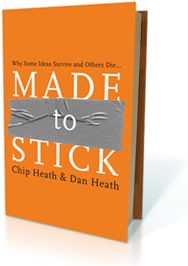Made to Stick: Why Some Ideas Survive and Others Die

This book is closely related to the Contagious book I reviewed last week — after all, for an idea to be contagious, it has to be sticky enough to be passed on along to at least more than one person. You’ll see a lot of overlapping elements from the previous review in this one. In addition, the structuring of the book was similar — this book can be summed into one acronym as well: the SUCCESs model which defines the six traits that an idea needs to be sticky:
Simple
Simplicity is all about prioritizing the idea. It ruthlessly focuses on the core of your message. Southwest’s core message is that they are THE low fare airline. It’s always good if you can simplify your idea enough so that communicate with an analogy. Uber for X.
Unexpected
A sticky message is unexpected — it violates the norm, it’s packed with a punch. To keep attention of your audience, use curiosity gaps. You have to make your audience want to listen to you for the idea to stick afterwards. The chapter refers to the example of a Nordstrom sales staff who accepted used snow tires from a customer who wanted to return them, even though Nordstrom doesn’t sell snow tires! It’s so unexpected, and the idea so sticky that Nordstrom is now known for its impeccable customer service.
Concrete
John F. Kennedy’s dream of putting a man on the moon by the end of the decade was concrete, and thus sticky enough to actually get the job done. To make an idea concrete, use sensory language (like Aesop’s fables) or paint a picture (man on the moon!)
Credible
Ideas get credibility through outside authorities, or from within through vivid details. An idea endorsed by someone credible is way more sticky than one that is not. There were definitely some overlapping elements with the Robert Cialdini’s Influence book’s Authority section here: People want to follow credible, knowledgable experts, and the ideas they endorse.
Emotional
This was similar to the Emotional section in Contagious book. People care about other people, not numbers. Identity appeals often surpass self-interest: “Don’t mess with Texas” was a slogan used on a campaign to reduce littering on Texas roadways, and it was emotional enough not only for Texans to stop littering themselves, but also take pride in their cleaner roadways.
Stories
Stories can simulate what can happen, as well as provide motivation to do it. They can also help people see how an existing problem can change. We have seen importance of stories in the Contagious book as well, and I think packaging everything as a story is one of the top ways to make your ideas not only go viral, but also keep them sticky.
For next week, I’ll review another book by the same authors (Heath brothers) that came out in October 2017, and that I liked quite a bit as well: The Power of Moments. Funnily enough, they came up with an acronym to sum up ideas in that book as well, but decided not to emphasize it too much!
This is #9 in a series of book reviews published weekly on this site.
